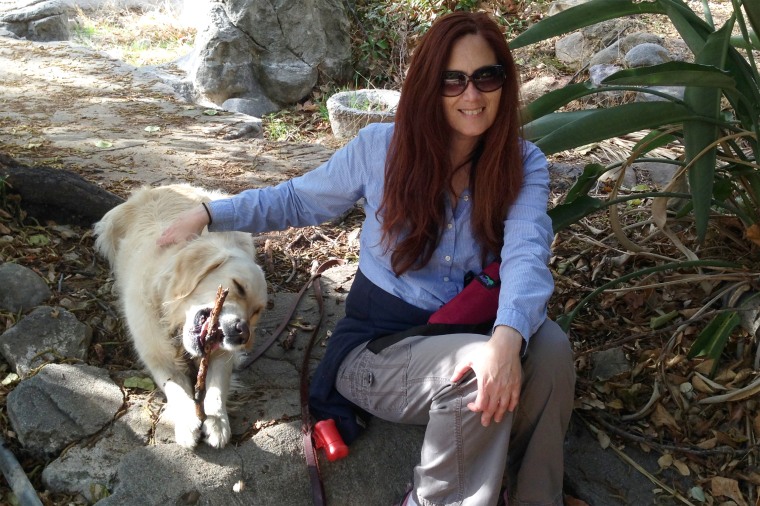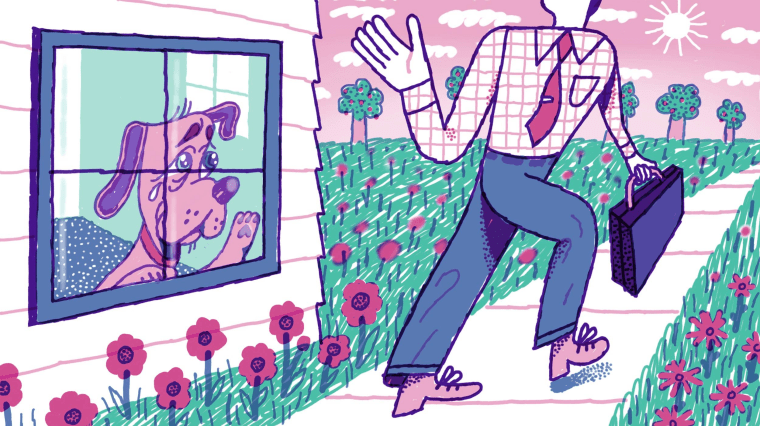Leaving the house just over a month ago to receive my first Covid-19 vaccination, I felt exhilarated — a milestone step toward some semblance of freedom. But when I returned a few hours later, I discovered that not everyone in my household was thrilled by the outing: Bronte, my 10-year-old golden retriever, had dragged my pajamas out of my bed and deposited them in the living room in a wet, pulpy, chewed-up mess.
Like so many pampered pooches whose owners have been home full time during the pandemic, Bronte has come to expect me to be by her side 24/7.
I was surprised that she had reverted back to such puppy-like behavior. She’s usually a well-adjusted, confident dog. However, like so many pampered pooches whose owners have been home full time during the pandemic, Bronte has come to expect me to be by her side 24/7.
As people get vaccinated and readjust to leaving home for work and school, their beloved canines need to readjust, too: The pandemic’s dog days are coming to an end.
That change can be hard for owners as well as pets. Steviee Hughes, the beverage director for a restaurant in Los Angeles who’s been furloughed since March 2020, has been used to having her 12-year-old pit bull, Zeus, constantly by her side.
“During this past year he went everywhere with me,” she said. “We went camping, to the store, random road trips. He was so happy I was home all day.”

But now, Hughes has returned to work four days a week. She said Zeus initially “seemed a little confused” as to why he couldn’t go with her when she left the house. Sometimes he seemed more than confused: “He acted out a few times, like peeing on my couch ottoman.”
While he’s still “a little bummed” that he can’t go to work with Hughes, she said he’s starting to get used to the new normal — particularly since, after Hughes’ recent move, it now includes a large patio.
“I even bought patio furniture that I knew he would enjoy lying on,” she said.
Professional dog trainer and dog behavior consultant Michelle Stern praised Hughes’ purchase.
"Setting your dog up with a comfortable space to rest when you’re gone is a great idea," Stern said, "and if they don’t show signs of destructive behavior, give them free rein of the house."
For my part, Bronte already has free rein of the house, and if I’m lucky, she lets me share a tiny corner of her “comfortable space” (i.e. my bed).
“Dogs are creatures of habit, and these types of transitions are hard for them,” Stern explained.
That’s why she recommended taking baby steps initially. (She noted that the techniques she’s offering are for the “average dog” and not those that suffer from separation anxiety, which is a panic disorder and requires a different approach.)
She suggested starting by leaving your dog alone in increments, even for just one or two minutes. It can be as simple as going to the bathroom or taking a shower. Unless of course, like me, you have a “water dog” whose favorite thing is to try and join you in the shower.
Once you’ve mastered the bathroom break, Stern suggested then walking around the block alone or having the dog hear you getting in the car and driving around the block.
“All of these baby steps help your dog realize that you always come back,” she said. “Some dogs like to sit and look out the window and wait for you to come back. That’s OK. That’s the dog giving itself a job, and a lot of dogs really need a job.”
Bronte considers it her job to stand by the window, or in the garden, and protect me from all enemies — foreign and domesticated. These include squirrels, birds, other dogs and what she considers the greatest affront to all creatures great and small: people on skateboards. (I’m inclined to agree.)
Stern had a solution for that, too.
“An effective and simple hack that I use is to buy frosted window cling film that allows light in but prevents the dogs from seeing visual triggers that make them bark,” she said.
She also recommended playing music or white noise to help keep dogs calm.
Of course, all of this can be even more difficult for dogs adopted by people during the pandemic precisely because they knew they would be home all day. Most of them are now experiencing separation from their owners for the first time.
The family of 11-year-old Paxton Booth, an actor on Disney Channel’s “Coop and Cami Ask the World,” were worried about that dynamic when they adopted their now year-old rescue mix, Ripley, from Paw Works at the beginning of the pandemic.
Paxton said the family talked about what they would do when it came to returning to work and school before they adopted Ripley and decided to put the puppy in doggy day care right away.
“We stayed inside and didn’t socialize,” Paxton said of the human members of the family. “So that meant Ripley didn’t get introduced to many new people. It made her a little fearful of anyone new she meets now. Thankfully, her doggy day care was able to stay open, so she had plenty of socialization and playtime with other dogs.”
To Bronte’s credit, she considers anyone — be it a lifelong friend, the neighbor who always stops by and gives her treats or a total stranger — an excellent companion. Let her play in the fountain 10 minutes from our house and buy her a Starbucks puppuccino and she won’t even ask to see your references.
Stern, who also hosts the podcast “Pooch Parenting,” said the Booths’ day care decision was an excellent one. And if you’re worried about how your dog is doing when home alone, Stern is all for using a video camera so you can check up on them.
“The average pet dog sleeps a lot during the day,” Stern said, “so if we can get our dogs comfortable enough so they can sleep, that’s something to strive towards.”
I take great pride in the fact that Bronte has a Ph.D. in sleeping (and, unfortunately, snoring).
Bronte considers it her job to stand by the window, or in the garden, and protect me from all enemies — foreign and domesticated.
When you do come home each day, Stern believes you should “say hello but not throw a party, because some dogs wait by the door and anticipate that party and that can cause some anxiety” for the dogs.
She also recommended a good walk before you head out to work.
“A walk around the block is not amazing exercise, but if you allow them time to sniff during that walk, they will experience a lot of mental satiation” due to the myriad olfactory neurons in their brain, she said. “It tends to help them be calmer.”
Thankfully there are myriad ways to ease the transition so both human and canine feel comfortable. And just as thankfully, I can simply throw my drool-filled pajamas in the washing machine.



